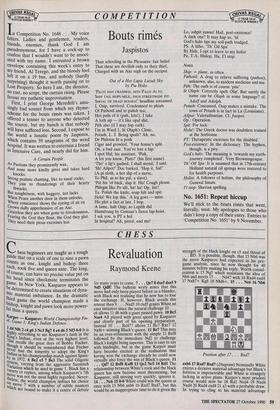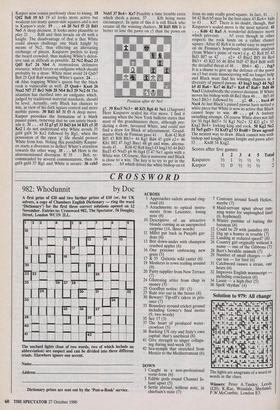CHESS
Revaluation
Raymond Keene
Chess beginners are taught as a rough guide that on a scale of one to nine a pawn counts as one, knight and bishop three each, rook five and queen nine. The king, of course, can have no precise value put on his head since checkmate terminates the game. In New York, Kasparov appears to be determined to create situations of dyna- mic material imbalance. In the dramatic third game the world champion made a -.'ishop , knight and pawn look more power- ful than a queen.
Karpov — Kasparov: World Championship Fin- al, Game 3; King's Indian Defence.
1 d4 NM 2 e4 g6 3 Nei Be 4 e4 d6 5 Nf3 0-0 It is highly refreshing to see Kasparov's faith in the ..,„4\14's Indian, even at the very highest level. 11111,. s recalls the great days of Bobby Fischer, though it should be remembered that Fischer never had the temerity to adopt the King's Liorlian in his championship match against Spass- ky in 1972. 6 Bet e5 7 Be3 The solid Gligoric system, varying from the aggressive Saemisch .. Variation which he used in game 1. Black has a variety of replies, among which Kasparov's 7th move was not the most highly regarded. Never- eless, the world champion imbues his choice °fir move 7 with a number of subtle nuances Which are bound to make it a centre of debate
for many years to come. 7 . . . Qe7 8 dxe5 dxe5 9 Nd5 Qd8! The bulletin wryly notes that this move had only been played before as a blunder, with Black not realising that he now has to lose the exchange. lf, however, Black avoids this retreat then 9 . Nxd5 10 cxd5 grants White an easy initiative since the natural challenge 10 . . c6 allows 11 d6 with a giant passed pawn. 10 Bc5 Nxe4 All played with great speed by Kasparov and clearly part of his opening preparation. Instead 10 . . Re8?? allows 11 Be7 Rxe7 12 Nxf6+ winning Black's queen. 11 Be7 This may be an over-refinement with the simple 11 BxfS followed by the immediate Nd2 to challenge Black's knight being superior. This is easy to say with hindsight, but in the game Karpov must have become excited at the realisation that having won the exchange already he could now virtually also force the win of Black's queen. 11
. . Qd7 12 BxN KxfS 13 Qc2 Nc5 14 Rdl The relationship between White's rook and the black queen has now become most threatening, but Kasparov, still moving very quickly, ignores it. 14 . . . Nc6 15 0-0 White could win the queen at once with 15 Nb6 axb6 16 Rxd7 Bxd7, but this would be an inappropriate time to do it given the
strength of the black knight on c5 and threat of . . Bf5. It is possible, though, that 15 Nb6 was the move Kasparov had expected in his pre- game analysis, since he now thought for 40 minutes before making his reply. Worth consid- eration is 15 Ng5 which maintains the idea of Nb6 and meets 15 . . . Nd4? with 16 Rxd4 exd4 17 Nxh7+ Kg8 18 Nhf6+. 15 . . . Ne6 16 Nb6 Position after 17 . . . Bxd7 axb6 17 Rxd7 Bxd7 (Diagram) Nominally White enjoys a decisive material advantage but Black's fortress is impenetrable and White is strangely lacking in active plans. Karpov's most prudent course would now be 18 Rdl Ncd4 19 Nxd4 Nxd4 20 Rxd4 cxd4 21 a3 with a probable draw. In trying to cling to his material advantage Karpov now comes perilously close to losing. 18 Qd2 Be8 19 b3 19 a3 looks more active but weakens too many queen-side squares and is not in Karpov's style. 19 . . . e4 20 Nel f5 21 Bdl Ne5 A deep decision. It looks more plausible to play 21 . . Rd8 and then invade on d4 with a knight. The disadvantage of that is that White could always challenge one black knight by means of Nc2, thus effecting an alleviating exchange of pieces. Kasparov prefers to keep the board crowded, thus making White's defen- sive task as difficult as possible. 22 Nc2 Rxa2 23 Qd5 Ke7 24 Nb4 A tremendous defensive resource, which forces an endgame which should probably be a draw. White must avoid 24 Qxb7 Bc6 25 Qc8 Ra8 winning White's queen. 24 . . . c6 Also trapping White's queen but the black rook is vulnerable as well. 25 Qxe6+ Kxe6 26 Nxa2 Nf7 27 Be2 Nd6 28 Nb4 Bc3 29 Nc2 f4 The situation has clarified into an endgame which, judged by traditional material standards, should be level. Actually, only Black has chances to win, in view of his dark square control and more mobile pawns. 30 Rdl h5 31 13 A deep move. Karpov provokes the formation of a black passed pawn, believing that he can safely block- ade it. 31 . . . e3 32 g3 g5 33 Bd3 h4 34 Kfl c5 35 Ke2 I do not understand why White avoids 35 gxf4 gxf4 36 Ke2 followed by Rgl, when the possession of the open g file should protect White from loss. Noting this possibility Kaspar- ov starts a diversion to deflect White's attention towards the other wing. 35 . . . b5 Here is the aforementioned diversion. If 35 . . . Bc6, re- commended by several commentators, then 36 gxf4 gxf4 37 Rgl and White is secure. 36 cxb5 NxbS 37 Bc4+ Ke7 Possibly a time trouble error which sheds a pawn, 37 . . . Kf6 being more circumspect. In spite of this it is still Black who retains all the winning chances. 38 Rd5 Bf6 It is better to lose the pawn on c5 than the pawn on Position after 41 Nel g5. 39 Rxc5 Nc3+ 40 Kfl Bg6 41 Nel (Diagram) Here Kasparov sealed his 41st move. I find it amazing when the New York bulletin states that most of the grandmasters there, although pre- dicting a draw, favoured White, and could not find a draw for Black at adjournment. Grand- master Nick de Firmian gave 41 . . . Kd6 42 Rc8 Bf5 43 Rf8 Bh3+ 44 Kgl Bd4 45 gxf4 e2+ 46 Khl Bf2 47 fxg5 Bxe 1 48 g6 and wins, alterna- tively 41 . . Kd6 42 Rc8 hxg3 43 hxg3 b5 44 Bd3 Bxd3 45 Nxd3 g4 46 fxg4 f3 47 Nel again with a White win. Of course, this is nonsense and Black is close to a win. The key is to try to get in the move . . . b5 which drives the white bishop on c4
from its only really good square. In fact, 41 - • h6 42 Rc6 b5 may be the best since 43 Re6+ fails to 43 . . . Kf7. There is no doubt, though, that Kasparov's sealed move is the most natural. 41 . . . Kd6 42 Ra5 A wonderful defensive move which prevents . . . b5 even though in other respects the rook lands on a rather clumsy square. After 42 Rc8 it is rather easy to improve on de Firmian's hopelessly optimistic analysis (from White's point of view) e.g. 42 Rc8 b5 43 Bd3 Bf7 or 42 . . . e2+ 43 Bxe2 Bf5 44 Rc4 Bh3+ 45 Kf2 b5 46 Rb4 Nd5 47 Re4 Bd8 with the dreadful threat of 48 . . Bb6+ . 42 . . . fxg3 It is a shame to give up the defence of the pawn On e3 but static manoeuvring will no longer help and Black must find his winning chances in a diversity of passed pawns. 43 hxg3 hxg3 44 Ng2 b5 45 Ra6+ Ke7 46 Ra7+ Ke8 47 Ra8+ BdS 48 Nxe3 Undoubtedly the correct decision. If White moves his bishop with 48 Be2 then 48 . . . Bf5 49 Nxe3 Bh3+ followed by . . . g2. 48 . . . bxc4 49 Nxc4 At last Black's passed pawns have netted a white piece but White is now so active that Black cannot hope to win. 49 . . . g4 A forlorn swindling attempt. Of course White does not fall for 50 fxg4 Bd3+ 51 Kgl Ne2+ 52 Kfl g2+ 53 Kxg2 Be4+ forking king and rook. 50 Kg2 Net 51 Ne5 gxf3 + 52 Kxf3 g2 53 Rxd8+ Draw agreed The neatest way to draw. Black cannot win with bishop and knight against knight and pawn after 53 . . . Kxd8 54 Kxg2.
Scores after five games: 1 2 3 4 5 Total
Kasparov 1/2 1 1/2 1/2 V2 3 Karpov 1/2 0 2



































































 Previous page
Previous page